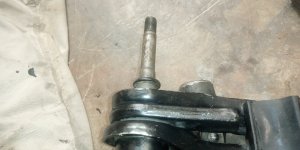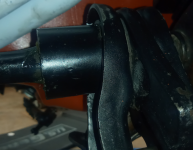If you've got the fore/aft room, you can get the engine/trans out as a unit by yourself. It's not a lot of fun, but it can be done. A chain swivel comes in handy but isn't strictly required. Put the engine crane as close to the wall/garage door as you dare, then roll the car up to it. Get your lifting apparatus situated, some tension in the chain, and remove the motor mount bolts/nuts. Jack the car up a bit so you can get to the trans crossmember. Support the trans with a floor jack and remove the crossmember. Put a wheel or furniture dolly, or an Exclusive Cart Designs by Bob™ creation under the tailshaft housing and remove the floor jack. Start lifting the engine until you're near firewall contact. Roll the car away from the crane for more clearance, then lift further. Repeat ad nauseum, rolling the car away from the stand and checking your trans dolly situation and tailshaft housing clearance. You may have to shift the dolly's position at some point. Eventually you'll be clear and high enough that you can grab the tailshaft housing, lift it, and rotate it so the engine is sideways to the car. It's not a difficult lift since the crane's doing 90% of the work. If the car rolls easily, you should be able to move it enough with your legs and butt/hip to get it out of the way whilst still holding the transmission. Once it's clear, lower the drivetrain to the floor.
Reversing the procedure entails the engine/trans assembly at a severe angle, then rolling the car up to it. Lifting the tailshaft again, you swing it over the fender/grille/core support and gently set it against the core support. Now you've got to pull the car back under the crane, being careful to not let the transmission bang or slide around on things much (go to St. Vinny's and buy a couple of cheap blankets for cushioning--couple of bucks). This time you can roll the crane toward the car as clearance permits. A ratchet strap between the crane's upright and the car will make this easier, especially if the ratchet end is near the crane's controls. Once the tailshaft's about to contact the floor, get your rolling apparatus under it. The trans will want to go under the car naturally, but you'll have to adjust the dolly now and again to maintain directional stability.
That's really glossing over it; it's pretty time-consuming. It won't go quickly so don't try to force the issue. That leads to errors (and usually damage). Notice I did not mention this being "easy", "fun" nor even particularly safe--but it is possible. I've done it on more than one occasion since I rarely have assistance. It's just one more reason I have a winch in the garage, along with a snatch block and floor anchors so the car can be pulled in either direction.
I may be doing exactly this if I decide to re-piston Agnes' engine. I really don't want to separate the bell in particular, since we've got quite a bit of time into centering it and there aren't any dowel pins to find that spot again. I might have to swap piston/rod assemblies whilst it's hanging from the crane. So be it.













